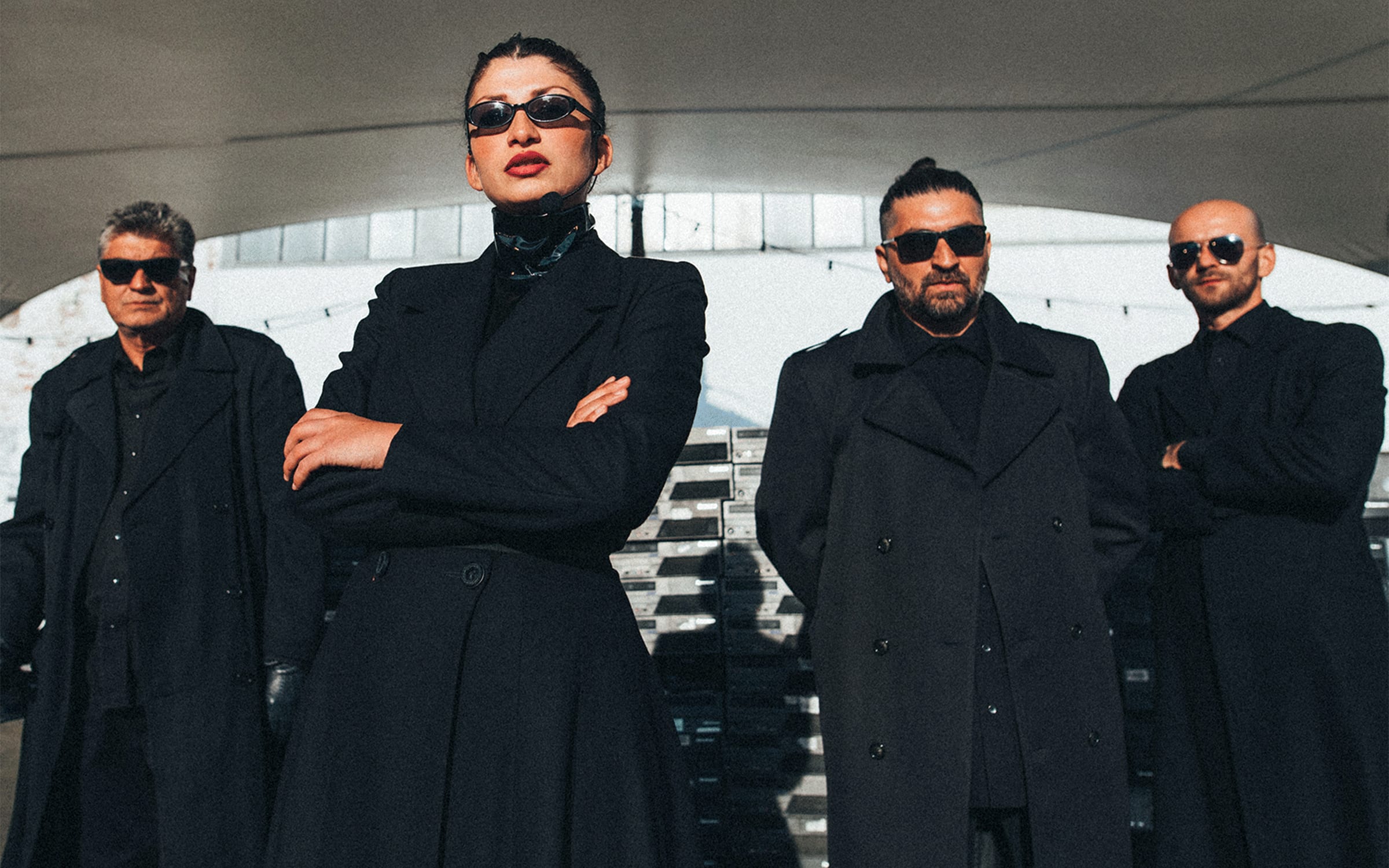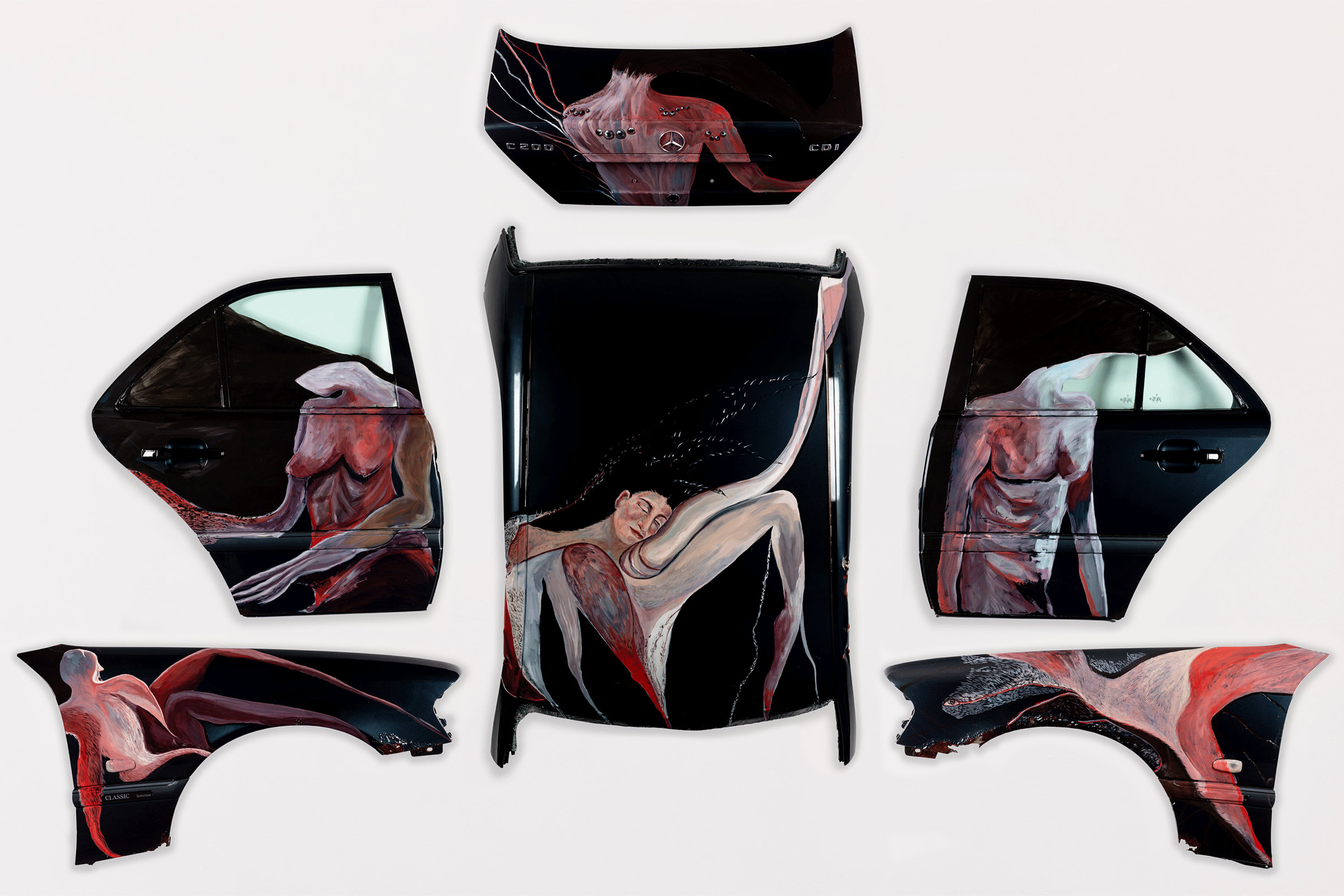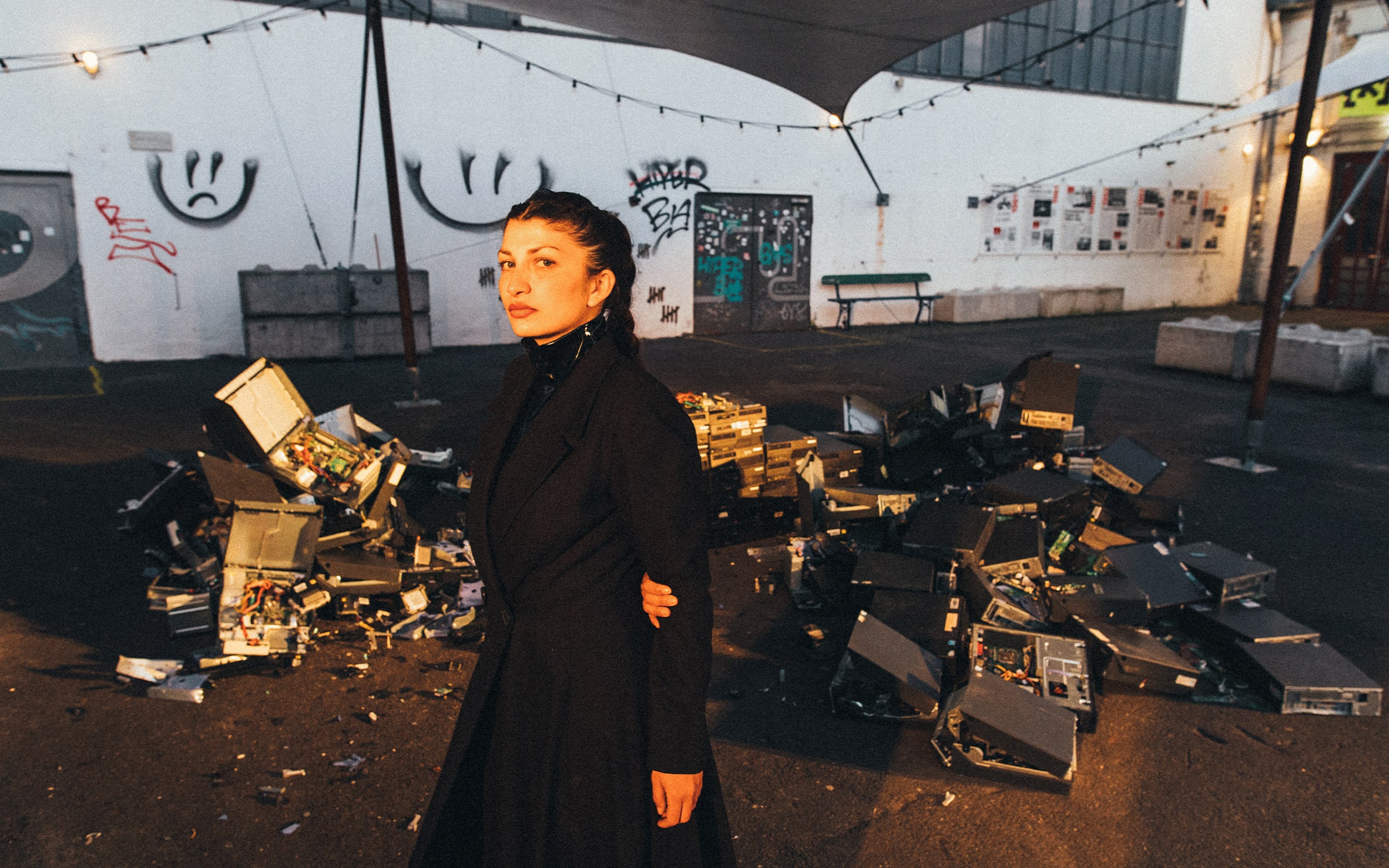‘Dear Omer, …’ Bosnian artist Selma Selman begins most of her recent Instagram posts with these two words. The salutation is either part of the caption or fills the post’s square as white or colored text on a black background. The statements that follow leave the reader guessing: ‘Dear Omer, you enter my life I exit yours.’ Or ‘Dear Omer, taking risks is my safe zone.’
On the train to meet Selman in Amsterdam, where she is currently an artist-in-residence at the Rijksakademie, I scroll through her profile. The text squares are interspersed with photos of the artist. In most of them, she is unsmiling, looking straight at the camera. A few images show Selman during her Motherboards performances (2023–ongoing) in which – with the help of family members – she demolishes computers to remove their Central Processing Units (CPU), which contain gold. During one iteration of the work, as part of Kampnagel’s Krass Festival in Hamburg in April, Selman and her relatives dressed in black and wore sunglasses, as if in a Wachowski sisters’ film.

I tell myself that my Instagram prowling is the tail end of my research on the artist. Still, ostensibly reading someone else’s love letters feels voyeuristic. Is Selman deliberately drawing in her followers only to make them slightly uncomfortable? I stop scrolling. My index finger hovers over a post that, for a change, is not prefaced by ‘Dear Omer’. In bold white letters on a black background, it reads: ‘I would like to differentiate myself from other artists who use the subject of the Roma in their works; my art uses the subject of the Roma as a component of my work, it is not the entirety of my work.’
A follower has reacted to the post with two clapping-hands emojis. I think of the many times I have witnessed stereotypical portrayals of Roma people as lazy, uneducated, and worse. Despite a widespread presence in the Balkans and beyond, the Roma remain marginalized as an ethnic group. Often, they are referred to in derogatory terms, such as in the films of Serbian director Emir Kusturica. Yet, the art world’s expectations of Selman, who grew up in a Roma family, surely include no such caricatures. I close the app, disembark at Amsterdam Central Station, and arrive at the Rijksakademie – one of the most prestigious art institutions in the Netherlands – during a downpour. Selman, who is in her second and final year of residency, comes to greet me at the gate.
She immediately guides me to the ceramics workshop, where she is preparing her project for Rijksakademie Open Studios 2023. With technical advisor Stephan Kuderna, Selman is extracting gold from CPUs. It is a complicated process: Science and alchemy in equal parts. The dust from ground-down CPUs is placed on small sheets of lead, which are hammered and squeezed shut. These ‘envelopes’ are then placed in hot cupels – tiny, crucible-shaped objects made from bone ash or magnicide – inside a ceramics kiln. The lead and oxides are diffused into the cupel. What remains is a gold pearl. Selman aims to use the accumulated pearls to create a sculpture of a golden nail hammered into a wall.
After the materials are in the kiln, Selman walks me to the paint and resins atelier. The day before, the artist – along with technician Arend Nijkamp – finished the work she will be presenting at Art Basel: six, gloss-coated car parts retrieved from a Mercedes, on which Selman has painted spiderlike figures.

This is not the first time the artist has used car parts as supports for her work. At documenta fifteen in 2022, she also presented paintings on car hoods and doors. Titled Paintings on Metal, these works were more figurative than the ones she is exhibiting this year. Another difference between the paintings on view in Kassel and those in Basel is that this is the first time Selman has meticulously cleaned, sprayed, and sanded the surfaces so that they gleam like a brand new car – albeit one animalistic in form. ‘I like to play with the reality of the object,’ Selman tells me. ‘How do I dismantle it and make it alive again? The painted car parts look a little like insects; like they are protecting themselves but also as if they are ready to attack at any moment.’ This dematerialization process, as the artist calls it, relates to cyberfeminism, a philosophy that challenges gender stereotypes in relation to technology and examines the connection between humans and machines. Selman describes the works as ‘dismantled creatures which are forming other new bodies.’
After receiving the ZVONO Award for the best young artist in Bosnia and Herzegovina in 2014, Selman won a full scholarship to undertake a master’s degree in the United States, which she obtained at Syracuse University. Sitting in her large studio, she explains that her art career began before she had even decided to study art. Aged just 17, Selman was producing five paintings day to sell through a business she ran with her father in her Bosnian hometown of Bihać. So, by the time she started her bachelor’s program at the Academy of Arts in Banja Luka, Selman had already been working as a commercial artist for several years. At the academy, she began experimenting with video and performance art as well as with painting on metal – a material she knew well and had at her disposal since her family owns a scrapyard. Selman’s art often incorporates knowledge passed down by her parents and she heeds their advice – whether on handling metal or on the direction a project should take. She explains her reliance on outside guidance by paraphrasing Croatian artist Mladen Stilinović: Every place is a good place to learn.
Selman sometimes gets the feeling that she has not worked hard enough. Then she thinks about what her art – which is highly acclaimed in her home country – has meant for people looking up to her: ‘I’ve changed the perception of Roma people for non-Roma people. The representation I offer of myself is also a new way of looking at a minority,’ she explains. She never wanted to escape her identity; she just did not want to be put in a box. This is one reason that she is interested in quantum physics, in how quantum atoms can travel everywhere at once. According to her, this phenomenon beautifully explains the human condition and underpins her work: ‘We are never just one thing, one identity,’ she says. ‘That is why I never put myself or any of my protagonists in the position of a victim.’
Suddenly, Selman’s phone buzzes. Kuderna is calling: The pearl is ready. We return to the ceramics workshop where he is standing outside an open door smoking a cigarette. The rain is still coming down in buckets. ‘Haven’t you opened the oven yet?’ Selman asks. ’No, I was waiting for you!’ Kuderna replies. Later, they stoop over a half-broken cupel. Inside lies a tear-shaped drop of glowing gold. Selman aims to stay in Amsterdam after her residency ends, to explore what the city has to offer her, and what she can give it in return.

As I exit the building, I think of Omer, the ‘man’ who never writes back. Selman created this cyber presence to express herself. ‘All my ex-boyfriends and lovers think it’s about them,’ she tells me, but this is not what Omer means to her. The ‘Dear Omer’ posts are a way of communicating with the world. On her Instagram, she is the creator speaking to her creation. As an artist, she is also the one in control. Selman does not let herself be defined by one aspect of her identity – she embodies all of them at once.
Selma Selman is represented by acb, Budapest. In June, her work will be on view in the Unlimited sector at Art Basel.
Lena van Tijen is a writer, critic, and translator. In 2022, she won the Young Art Critic Prize – an award to encourage young contemporary art writers from the Dutch-Flemish-speaking area.
Published on May 31, 2023.
Caption for full-bleed images, from top to bottom: 1. Selma Selman, Mercedes Matrix, 2019. Installation view at Manifesta 14, Prishtina, 2022. Photograph by Majlinda Hoxha. 2. Selma Selman, Paintings on Metal, 2022. © documenta fifteen: OFF-Biennale Budapest, installation view, Fridericianum, Kassel, 2022. Photograph by Nicolas Wefers. 3. Selma Selman, Paintings on metal, 2022, “Open Studios 2022” installation view at Rijksakademie, Amsterdam, 2022. Photograph by Sander van Wettum.